Jaesik Park
Holistic Order Prediction in Natural Scenes
Oct 02, 2025Abstract:Even in controlled settings, understanding instance-wise geometries is a challenging task for a wide range of visual models. Although specialized systems exist, modern arts rely on expensive input formats (category labels, binary segmentation masks) and inference costs (a quadratic amount of forward passes). We mitigate these limitations by proposing InstaFormer, a network capable of holistic order prediction. That is, solely given an input RGB image, InstaFormer returns the full occlusion and depth orderings for all the instances in the scene in a single forward pass. At its core, InstaFormer relies on interactions between object queries and latent mask descriptors that semantically represent the same objects while carrying complementary information. We comprehensively benchmark and ablate our approach to highlight its effectiveness. Our code and models are open-source and available at this URL: https://github.com/SNU-VGILab/InstaOrder.
* 25 pages, 11 figures, 6 tables
Tree-Guided Diffusion Planner
Aug 29, 2025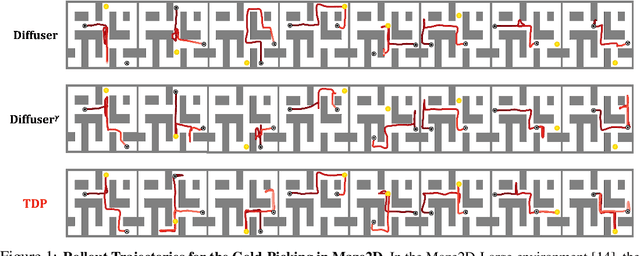

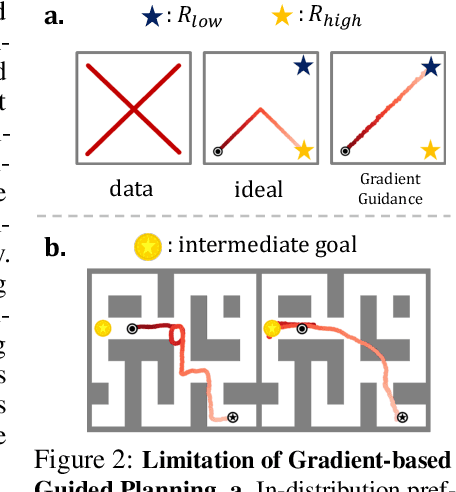

Abstract:Planning with pretrained diffusion models has emerged as a promising approach for solving test-time guided control problems. However, standard gradient guidance typically performs optimally under convex and differentiable reward landscapes, showing substantially reduced effectiveness in real-world scenarios involving non-convex objectives, non-differentiable constraints, and multi-reward structures. Furthermore, recent supervised planning approaches require task-specific training or value estimators, which limits test-time flexibility and zero-shot generalization. We propose a Tree-guided Diffusion Planner (TDP), a zero-shot test-time planning framework that balances exploration and exploitation through structured trajectory generation. We frame test-time planning as a tree search problem using a bi-level sampling process: (1) diverse parent trajectories are produced via training-free particle guidance to encourage broad exploration, and (2) sub-trajectories are refined through fast conditional denoising guided by task objectives. TDP addresses the limitations of gradient guidance by exploring diverse trajectory regions and harnessing gradient information across this expanded solution space using only pretrained models and test-time reward signals. We evaluate TDP on three diverse tasks: maze gold-picking, robot arm block manipulation, and AntMaze multi-goal exploration. TDP consistently outperforms state-of-the-art approaches on all tasks. The project page can be found at: tree-diffusion-planner.github.io.
Exploring Multimodal Diffusion Transformers for Enhanced Prompt-based Image Editing
Aug 11, 2025Abstract:Transformer-based diffusion models have recently superseded traditional U-Net architectures, with multimodal diffusion transformers (MM-DiT) emerging as the dominant approach in state-of-the-art models like Stable Diffusion 3 and Flux.1. Previous approaches have relied on unidirectional cross-attention mechanisms, with information flowing from text embeddings to image latents. In contrast, MMDiT introduces a unified attention mechanism that concatenates input projections from both modalities and performs a single full attention operation, allowing bidirectional information flow between text and image branches. This architectural shift presents significant challenges for existing editing techniques. In this paper, we systematically analyze MM-DiT's attention mechanism by decomposing attention matrices into four distinct blocks, revealing their inherent characteristics. Through these analyses, we propose a robust, prompt-based image editing method for MM-DiT that supports global to local edits across various MM-DiT variants, including few-step models. We believe our findings bridge the gap between existing U-Net-based methods and emerging architectures, offering deeper insights into MMDiT's behavioral patterns.
CF3: Compact and Fast 3D Feature Fields
Aug 07, 2025Abstract:3D Gaussian Splatting (3DGS) has begun incorporating rich information from 2D foundation models. However, most approaches rely on a bottom-up optimization process that treats raw 2D features as ground truth, incurring increased computational costs. We propose a top-down pipeline for constructing compact and fast 3D Gaussian feature fields, namely, CF3. We first perform a fast weighted fusion of multi-view 2D features with pre-trained Gaussians. This approach enables training a per-Gaussian autoencoder directly on the lifted features, instead of training autoencoders in the 2D domain. As a result, the autoencoder better aligns with the feature distribution. More importantly, we introduce an adaptive sparsification method that optimizes the Gaussian attributes of the feature field while pruning and merging the redundant Gaussians, constructing an efficient representation with preserved geometric details. Our approach achieves a competitive 3D feature field using as little as 5% of the Gaussians compared to Feature-3DGS.
Metropolis-Hastings Sampling for 3D Gaussian Reconstruction
Jun 15, 2025Abstract:We propose an adaptive sampling framework for 3D Gaussian Splatting (3DGS) that leverages comprehensive multi-view photometric error signals within a unified Metropolis-Hastings approach. Traditional 3DGS methods heavily rely on heuristic-based density-control mechanisms (e.g., cloning, splitting, and pruning), which can lead to redundant computations or the premature removal of beneficial Gaussians. Our framework overcomes these limitations by reformulating densification and pruning as a probabilistic sampling process, dynamically inserting and relocating Gaussians based on aggregated multi-view errors and opacity scores. Guided by Bayesian acceptance tests derived from these error-based importance scores, our method substantially reduces reliance on heuristics, offers greater flexibility, and adaptively infers Gaussian distributions without requiring predefined scene complexity. Experiments on benchmark datasets, including Mip-NeRF360, Tanks and Temples, and Deep Blending, show that our approach reduces the number of Gaussians needed, enhancing computational efficiency while matching or modestly surpassing the view-synthesis quality of state-of-the-art models.
Improving Editability in Image Generation with Layer-wise Memory
May 02, 2025
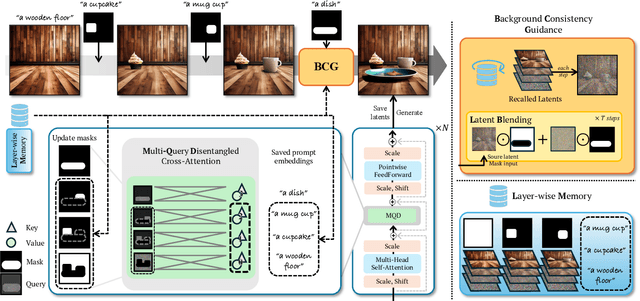
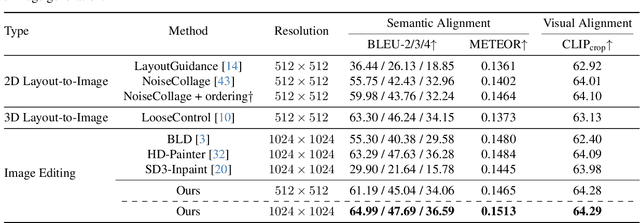
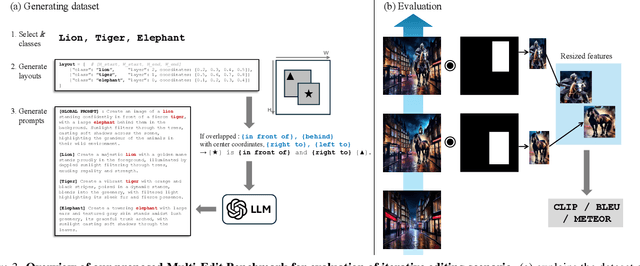
Abstract:Most real-world image editing tasks require multiple sequential edits to achieve desired results. Current editing approaches, primarily designed for single-object modifications, struggle with sequential editing: especially with maintaining previous edits along with adapting new objects naturally into the existing content. These limitations significantly hinder complex editing scenarios where multiple objects need to be modified while preserving their contextual relationships. We address this fundamental challenge through two key proposals: enabling rough mask inputs that preserve existing content while naturally integrating new elements and supporting consistent editing across multiple modifications. Our framework achieves this through layer-wise memory, which stores latent representations and prompt embeddings from previous edits. We propose Background Consistency Guidance that leverages memorized latents to maintain scene coherence and Multi-Query Disentanglement in cross-attention that ensures natural adaptation to existing content. To evaluate our method, we present a new benchmark dataset incorporating semantic alignment metrics and interactive editing scenarios. Through comprehensive experiments, we demonstrate superior performance in iterative image editing tasks with minimal user effort, requiring only rough masks while maintaining high-quality results throughout multiple editing steps.
ShowMak3r: Compositional TV Show Reconstruction
Apr 28, 2025Abstract:Reconstructing dynamic radiance fields from video clips is challenging, especially when entertainment videos like TV shows are given. Many challenges make the reconstruction difficult due to (1) actors occluding with each other and having diverse facial expressions, (2) cluttered stages, and (3) small baseline views or sudden shot changes. To address these issues, we present ShowMak3r, a comprehensive reconstruction pipeline that allows the editing of scenes like how video clips are made in a production control room. In ShowMak3r, a 3DLocator module locates recovered actors on the stage using depth prior and estimates unseen human poses via interpolation. The proposed ShotMatcher module then tracks the actors under shot changes. Furthermore, ShowMak3r introduces a face-fitting network that dynamically recovers the actors' expressions. Experiments on Sitcoms3D dataset show that our pipeline can reassemble TV show scenes with new cameras at different timestamps. We also demonstrate that ShowMak3r enables interesting applications such as synthetic shot-making, actor relocation, insertion, deletion, and pose manipulation. Project page : https://nstar1125.github.io/showmak3r
Subject-driven Video Generation via Disentangled Identity and Motion
Apr 23, 2025Abstract:We propose to train a subject-driven customized video generation model through decoupling the subject-specific learning from temporal dynamics in zero-shot without additional tuning. A traditional method for video customization that is tuning-free often relies on large, annotated video datasets, which are computationally expensive and require extensive annotation. In contrast to the previous approach, we introduce the use of an image customization dataset directly on training video customization models, factorizing the video customization into two folds: (1) identity injection through image customization dataset and (2) temporal modeling preservation with a small set of unannotated videos through the image-to-video training method. Additionally, we employ random image token dropping with randomized image initialization during image-to-video fine-tuning to mitigate the copy-and-paste issue. To further enhance learning, we introduce stochastic switching during joint optimization of subject-specific and temporal features, mitigating catastrophic forgetting. Our method achieves strong subject consistency and scalability, outperforming existing video customization models in zero-shot settings, demonstrating the effectiveness of our framework.
Targetless LiDAR-Camera Calibration with Anchored 3D Gaussians
Apr 06, 2025
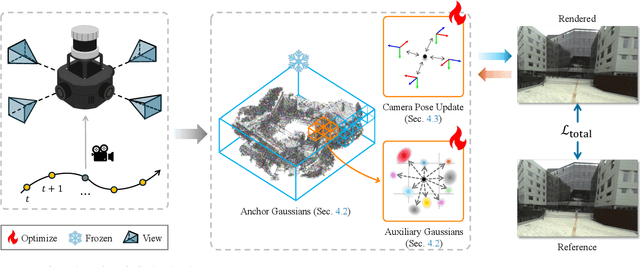

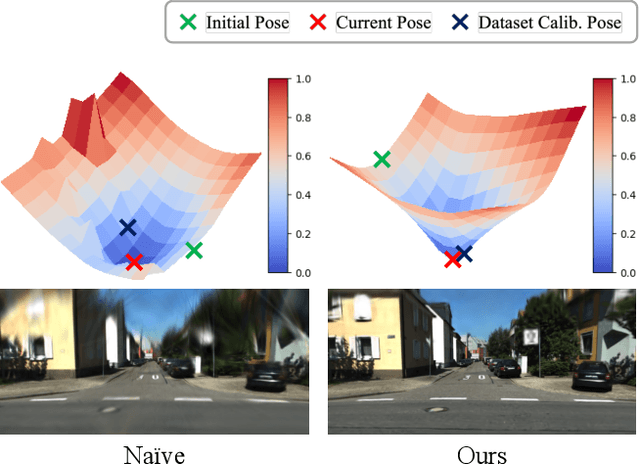
Abstract:We present a targetless LiDAR-camera calibration method that jointly optimizes sensor poses and scene geometry from arbitrary scenes, without relying on traditional calibration targets such as checkerboards or spherical reflectors. Our approach leverages a 3D Gaussian-based scene representation. We first freeze reliable LiDAR points as anchors, then jointly optimize the poses and auxiliary Gaussian parameters in a fully differentiable manner using a photometric loss. This joint optimization significantly reduces sensor misalignment, resulting in higher rendering quality and consistently improved PSNR compared to the carefully calibrated poses provided in popular datasets. We validate our method through extensive experiments on two real-world autonomous driving datasets, KITTI-360 and Waymo, each featuring distinct sensor configurations. Additionally, we demonstrate the robustness of our approach using a custom LiDAR-camera setup, confirming strong performance across diverse hardware configurations.
Recovering Dynamic 3D Sketches from Videos
Mar 27, 2025Abstract:Understanding 3D motion from videos presents inherent challenges due to the diverse types of movement, ranging from rigid and deformable objects to articulated structures. To overcome this, we propose Liv3Stroke, a novel approach for abstracting objects in motion with deformable 3D strokes. The detailed movements of an object may be represented by unstructured motion vectors or a set of motion primitives using a pre-defined articulation from a template model. Just as a free-hand sketch can intuitively visualize scenes or intentions with a sparse set of lines, we utilize a set of parametric 3D curves to capture a set of spatially smooth motion elements for general objects with unknown structures. We first extract noisy, 3D point cloud motion guidance from video frames using semantic features, and our approach deforms a set of curves to abstract essential motion features as a set of explicit 3D representations. Such abstraction enables an understanding of prominent components of motions while maintaining robustness to environmental factors. Our approach allows direct analysis of 3D object movements from video, tackling the uncertainty that typically occurs when translating real-world motion into recorded footage. The project page is accessible via: https://jaeah.me/liv3stroke_web
 Add to Chrome
Add to Chrome Add to Firefox
Add to Firefox Add to Edge
Add to Edge